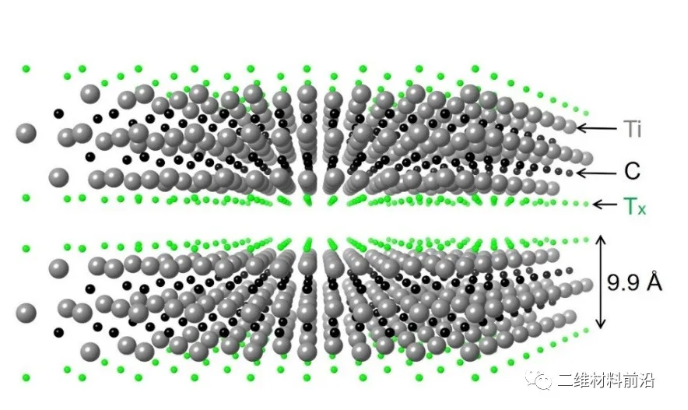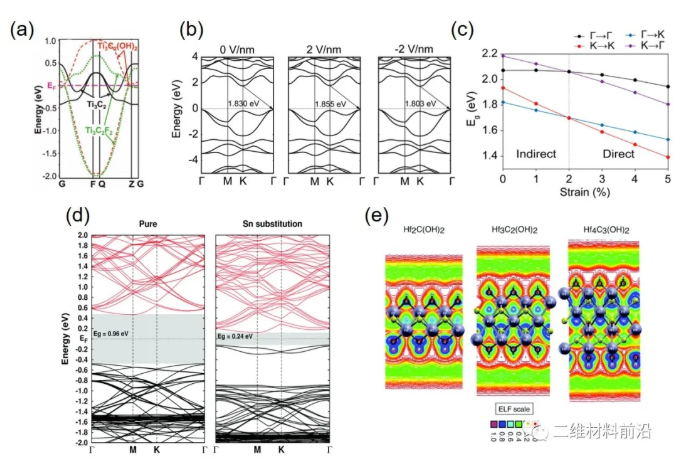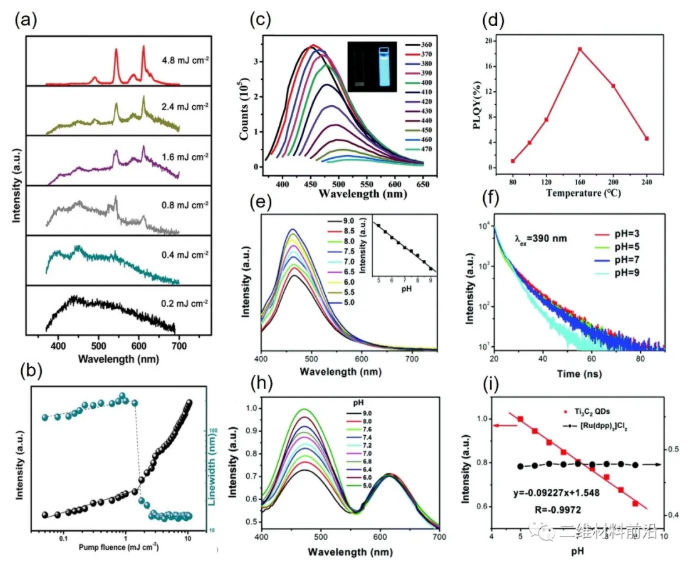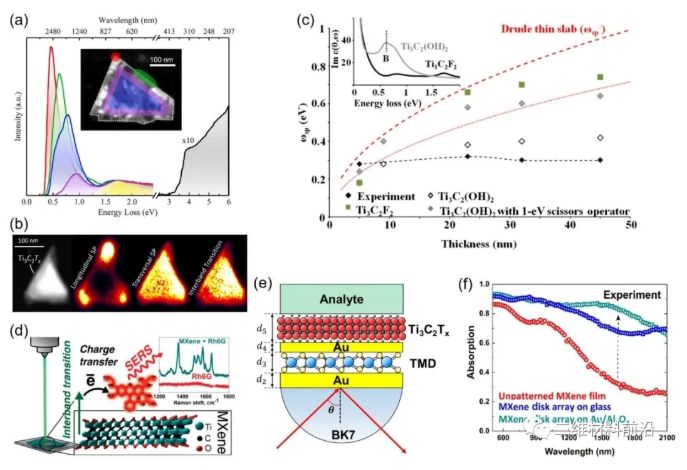
hotline:
17715390137
Tel/Wechat:
18101240246 (Technology)
0512-68565571
Email:mxenes@163.com (Sales Engineer)bkxc.bonnie@gmail.com
Scan the code to follow or search the official account on WeChat:
2D Materials Fronrier After paying attention,
click on the lower right corner to contact us,
Enter enterprise WeChat.
Professional Services Online

已传文件:photo/202073092054968.png
1. Introduction to MXene
First, briefly review the development history of MXene. The first MXene material (Ti3C2Tx, as shown in Figure 1) was discovered by Yury Gogotsi and Michel W. Barsoum‘s PhD student Michael Nguib while studying the MAX material Ti3AlC2 as a lithium-ion battery electrode.
Of course, the Yury group has already carried out many preliminary attempts before this. For example, the first research material was Ti3SiC2 instead of Ti3AlC2; and it also designed fluorine gas, hydrogen fluoride gas and some molten salt etching methods (at the time these etchants The main purpose is to etch titanium or silicon to increase lithium ion insertion channels).
In addition, Michel W. Barsoum is known as the "Father of MAX" and guided MAX‘s performance and specific experiments. Therefore, the three inventors have made important contributions to the birth of MXene.
Generally, MXene specifically refers to a material system composed of Mn+1XnTx elements, where M represents an early transition metal element, X represents C or N, and T refers to the group/modifier on the surface of the two-dimensional material. n usually ranges from 1-3. Therefore, the MXene family has a rich chemical composition, many members, and is still expanding. Figure 2 summarizes the development history, material types and preparation methods of MXene.

Figure 1 Schematic diagram of the atomic structure of the first MXene Ti3C2Tx
(The thickness of a single layer is about 9.9Å)

Figure 2 The development history, material types, and preparation methods of MXene
2. Optical performance of MXene
Generally, the linear optical properties (such as absorption, transmission, and photoluminescence) and nonlinear optical properties (such as saturated absorption, nonlinear refractive index) of MXene are highly dependent on its energy structure (such as band gap, direct/indirect band) Gap, topological properties, etc.), more specifically, its dispersion characteristics and nonlinear dielectric function (ε) or refractive index (n).
In general, the optical properties of a medium can be described by its dielectric function ε(ω):
Where ω is the optical frequency, and ε1(ω) and ε2(ω) are the real and imaginary parts, respectively. After the electronic ground state is determined, the dielectric function can be calculated in the momentum representation, which requires the conversion of matrix elements between the electronic eigenstate and the electronic eigenstate. Specifically, the imaginary part of the dielectric function can be determined by adding the following equation to the empty state:
Where e, m, Ω and are the electronic charge, mass, crystal volume and Fermi distribution, respectively. Represents the crystal wave function corresponding to the nth eigenvalue corresponding to the crystal momentum k and spin σ. The real part ε1(ω) can be obtained from the imaginary part ε2(ω) using the Kramers-Kronig transform. Once the dielectric function ε(ω) is determined, the optical properties of MXene, such as refractive index, reflectivity, and absorption or gain coefficient, can be estimated based on standard optical relationships.
In addition, due to the momentum mismatch of the inter-band transition, photons with energy equal to the band gap cannot be absorbed by the indirect band gap MXenes, and higher photon energy is usually required to excite the electronic transition. Therefore, the indirect band gap MXene (such as Ti2CO2) can further extend its high transmission window to higher optical frequencies. In metal or metal-like MXene materials, in-band transitions with energy less than 1ev should also be considered, and an additional Drude term should be used to correct the dielectric constant:
Where ωp is the plasma frequency and γD is the damping parameter. Enhanced plasma electron absorption has been observed in Ti3C2Tx MXene above 1300 nm (~0.95 eV).
It is worth noting that the band structure of MXene is affected by many factors. For example, the chemical composition of MXene, crystal structure, size (single layer, quantum dots, etc.), surface chemical groups, applied electric field, stress/deformation, doping, electronic localized state, etc.

Figure 3 briefly summarizes several typical factors that affect the energy level structure of MXene. Therefore, it is not an easy task to accurately determine the energy level structure of a specific MXene material and its related optical properties.
Figure 3 Several typical factors affecting the electronic energy state of MXene
(A) Surface group (b) Applied electric field (c) Stress
(D) Doping (e) Electronic local state
2.1 Linear optics
At present, many research groups have reported that MXene film has a broadband optical transmittance of more than 90%, even better than graphene materials. People spin-coated Ti3C2Tx MXene film with a thickness of 1.2nm on glass, quartz, and polyetherimide substrates, and found that it has only 3% ultra-low light attenuation in the visible light band.
Generally, the absorption of single-layer graphene in the visible light region is 2.3%. Considering that Ti3C2Tx MXene is ~3 times thicker than single-layer graphene, this indicates that Ti3C2Tx MXene has a higher light transmittance (see Figure 4f). In addition, it has been found that increasing the c-axis lattice distance of MXene by intercalation of macromolecular ions can further increase the transmittance.
It is also found in the experiment that MXene has a characteristic absorption peak near 800 nm, which is mainly derived from the transition between the bands outside the MXene plane. Transparent conductive MXene film can be made into a series of functional devices, such as flexible supercapacitors, flexible transparent electrodes, etc. (as shown in Figure 4c).

Figure 4 Linear optical performance of MXene
(A) The in-plane () dispersion and out-of-plane () dispersion of the imaginary part of the dielectric constant are calculated. (B) Absorption coefficient dispersion of pure Ti3C2 MXene modified with surface groups. (C) Highly transparent Ti3C2Tx MXene conductive film on flexible PET substrate. (D) The UV-vis-NIR linear light attenuation of Ti3C2Tx MXene film varies with deposition thickness. (E) The imaginary (top) and real (bottom) permittivity dispersion calculated based on the experimental results of (d). (F) Compared with reduced graphene oxide (rGO), Ti3C2Tx MXene has lower light attenuation in the visible light region
2.2 Glow
Most of the MXene materials discovered so far have metal-like properties, and their band gaps are not opened or are small. However, by reducing the size of MXene, the formation of direct energy bands allows radiant electron transitions, and both MXenes quantum dots and nanosheets show good photoluminescence properties.
Generally, MXene quantum dots can observe three absorption peaks at 260nm, 310nm and 350nm, depending on their particle size and composition. The photoluminescence spectrum is also highly dependent on the excitation wavelength.
As the excitation wavelength changes from 340 to 440 nanometers, the PL spectrum exhibits a span from 400 to 600 nanometers (see Figure 5c). The currently reported nitrogen-doped Ti3C2 quantum dots have a photoluminescence quantum yield of up to 18.7% and a luminescence lifetime of 7.06 ns, which can be adjusted by changing the preparation parameters (Figure 5d).
By increasing the intensity of the pump light, MXene can also be used as the gain medium of a random laser (Random Laser) to obtain a "white light" light source (see Figure 5a, 5b). The luminescence of MXene has selective emission quenching characteristics for ions in solution, such as Na+, Mg2+, Cu2+, K+, Mn2+, Zn2+, Ca2+, Al3+, Ce3+, Cu+, Ni2+, and so on. A series of biological species can be developed accordingly. And environmental diagnostic analysis tools. In addition, MXene can also be combined with Cy3 for high-resolution molecular biological imaging and ratio detection.

Figure 5 Luminous performance of MXene
(A) The emission spectrum of V2C MXene quantum dots excited by a 355nm pulsed laser. Emission peaks: 490nm, 545nm, 587nm, 613nm, and (b) the emission intensity and line width of the 490nm wavelength. (C) Photoluminescence spectra of Ti3C2 quantum dots under different excitation wavelengths. (D) The PL quantum yield efficiency of Ti3C2 quantum dots varies with the hydrothermal preparation temperature, and the highest yield efficiency is 18.7% at 160°C. (E) The pH dependence of the emission intensity of Ti3C2 quantum dots. The illustration shows the change in intensity with pH. (F) The emission lifetime of Ti3C2 quantum dots at different pH values. (H) The emission spectra of Ti3C2 quantum dots and [Ru(dpp)3]Cl2 mixtures at 490nm and 615nm under different pH values. (I) The emission peaks of Ti3C2 quantum dots at 490nm and 615nm vary with the pH value
2.3 Nonlinear optics
Non-linear optics refers to the polarization of the medium caused by the strong oscillating electric field under the incidence of strong laser light. This polarization not only oscillates with the frequency of the external electric field, but also produces high-order harmonic oscillations, and even DC electric field components. Compared with other two-dimensional materials, there is less research on the nonlinear optical properties of MXene, mainly focusing on the third-order nonlinear optical effects, such as saturable absorption and optical limiting effects. Commonly used detection methods are open-hole and closed-hole Z-scan methods.
The broadband saturable absorption characteristics of MXene can be used to generate femtosecond lasers (114 fs) from visible light to mid-infrared, as shown in Figure 6g-6i. MXene can also be combined with C60 (C60 has optical limiting characteristics) to form a photonic diode with broken time symmetry inversion (Figure 6c). In addition, the nonlinear refractive index of MXene can also be applied to applications such as all-optical modulation and frequency conversion (such as four-wave mixing) (Figure 6d).

Figure 6 Nonlinear optical characteristics of MXene and its applications
(A) Z-scan nonlinear optical test. (B) The non-linear transmittance of Ti3C2Tx film was measured by the open-hole Z-scan method. (C) Ti3C2Tx/C60 double-layer film photonic diode. (D) Ti3C2Tx MXene nanosheet all-optical switch. (E) At 1550nm, the absorption coefficient of Ti3C2Tx varies with the laser intensity. (F) At 800nm, 1064nm, 1550nm, and 1800nm wavelengths, the effective nonlinear absorption coefficient (βeff) is a function of the incident pulse energy (Ep). (G) Mid-infrared Er:ZBLAN laser resonator using inkjet printing of MXene saturable absorber (MXene-SA). (H) The output wavelengths of four pulsed lasers with MXene as a saturable absorber, and (i) the pulse widths obtained at four wavelengths. The shortest pulse width achieved is 114fs.
2.4 Surface plasmon
The metallic properties of two-dimensional layered MXene provide a good platform for photon-electron coupling on its surface. The high degree of light confinement achieved by exciting surface plasmons (SP) has a wide range of applications in biological, chemical and optical sensors, and surface enhanced Raman spectroscopy (SERS).
Using high-resolution transmission electron energy loss spectroscopy (EELS), it is proved that the surface plasma frequency of Ti3C2 MXene film can be tuned in the mid-infrared region by controlling the functionalization and thickness of the film. Moreover, the lateral surface plasmon sub-modes and inter-band transitions are uniformly distributed on the single-layer and multi-layer sheets, while the longitudinal multi-pole modes (super-radiation and sub-radiation) exhibit strong energy and spatial dependence, depending on the sheet’s Shape, such as shape, size, and thickness. In addition, the desorption of surface groups caused by the annealing process will also change the free electron density of the MXene sheet metal, resulting in a monotonous blue shift of all modes of SP.
Using the plasma characteristics of MXene, a series of applications can be developed. Ti3C2Tx nanosheets can be mixed with precious metals such as Ag, Au and Pd to achieve surface enhanced Raman spectroscopy (SERS). The enhancement factor of methylene blue dye is 105. A prism-coupled surface plasmon resonance (SPR) sensor with Kretschmann structure can be constructed as an effective optical sensor for biological or chemical analytes.
Recently, people have also proposed an SPR sensor based on the Au-Ti3C2Tx-Au-TMDs hybrid structure. Compared with the traditional Au film SPR sensor, its performance has increased by 41%. Researchers have prepared a superstructure surface composed of Ti3C2Tx nanodisk array on Au/Al2O3 substrate, which exhibits strong local surface plasmon resonance at near-infrared frequencies. This super-structured surface exhibits high-efficiency absorption (about 90%) on a 1.55μm broadband wavelength window, which can be applied to light absorption, biomedical imaging and sensing.

Figure 7 MXene plasmon characteristics and applications
(A) Zero energy loss EEL spectrum of triangular Ti3C2Tx thin slices. Inset: STEM-HAADF micrograph of Ti3C2Tx thin film on Si3N4 film. (B) Excite longitudinal SP, transverse SP and inter-band transition distribution on the same Ti3C2Tx sheet. (C) Extract ωSP as a function of MXene thickness from experimental data and calculations. Inset: Imε(0,ω) of Ti3C2F2 and Ti3C2(OH)2. (D) Schematic diagram of sprayed MXene SERS substrate for dye detection. (E) An SPR sensor based on the Au-Ti3C2Tx-Au-TMDs hybrid structure. (F) MXene plasma broadband absorption material. The patterned MXene disk array shows significant absorption enhancement in the near mid-infrared region
2.5 Light-to-heat conversion and biological applications
The photon-phonon conversion of MXene depends on the properties of incident light (such as wavelength, pulse duration, intensity), material absorption coefficient (including linear, nonlinear, and plasma absorption), as well as the morphology and concentration of the material. Specifically, photons of different energy usually experience different intensity attenuation, depending on whether the photon energy matches the energy band gap. Light pulses with pulses shorter than 1 ps will cause so-called adiabatic interaction, that is, photons cannot couple with phonons to achieve effective energy transfer.
Strong incident light will produce nonlinear optical phenomena and significantly affect the absorption coefficient. The multiple reflections and absorptions in multilayer MXene may result in higher light and heat efficiency than single-layer MXene. In addition, MXene quantum dots have photoluminescence, and thus may have lower non-radiative photothermal efficiency.
Technically speaking, the experimental characterization of photothermal efficiency will also be affected by the phonon dissipation characteristics and the environment. Using the photothermal properties of MXene, people have realized a variety of applications, such as water purification, microfluidic control, nanoparticle drive, photothermal tumor therapy, photo-acoustic imaging, photothermal all-optical interference/modulation, photodynamic therapy, photothermal Drug release and so on.
This information is from the Internet for academic exchange only, if there is any infringement, please contact us to delete it immediately
.

| Reminder: Beijing Beike New Material Technology Co., Ltd. supplies products only for scientific research, not for humans |
| All rights reserved © 2019 beijing beike new material Technology Co., Ltd 京ICP备16054715-2号 |